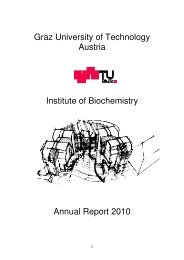Staff Members of the Institute of Biochemistry, TU - Institut für ...
Staff Members of the Institute of Biochemistry, TU - Institut für ...
Staff Members of the Institute of Biochemistry, TU - Institut für ...
You also want an ePaper? Increase the reach of your titles
YUMPU automatically turns print PDFs into web optimized ePapers that Google loves.
<strong>the</strong> metabolic flux <strong>of</strong> long chain fatty acids and very long chain fatty acids required for<br />
sphingolipid and glycerophospholipid syn<strong>the</strong>sis. Moreover, activity and expression levels <strong>of</strong><br />
fatty acid elongases, Elo1p and Elo2p, were enhanced as a consequence <strong>of</strong> reduced TAG<br />
lipolysis emphasizing <strong>the</strong> link to sphingolipid formation. Finally, <strong>the</strong> pattern <strong>of</strong><br />
phosphatidylcholine (PC), PE and PS molecular species was altered in tgl deletion strain<br />
underlining <strong>the</strong> important role <strong>of</strong> TAG turnover in maintenance <strong>of</strong> <strong>the</strong> pool size and<br />
remodelling <strong>of</strong> complex membrane lipids. This study shed new light on <strong>the</strong> physiological role<br />
<strong>of</strong> TAG lipases in yeast and in general.<br />
Figure 2: Domains <strong>of</strong> Tgl3p (from Rajakumari et al., 2010, in press)<br />
Even more surprising evidence was obtained when <strong>the</strong> enzymology <strong>of</strong> <strong>the</strong> three TAG lipases<br />
Tgl3p, Tgl4p and Tgl5p was studied in some detail. Motif search analysis indicated that Tgl3p<br />
and Tgl5p did not only contain <strong>the</strong> TAG lipase but also an acyltransferase motif (Figure 2).<br />
Interestingly, lipid analysis revealed that deletion <strong>of</strong> TGL3 resulted in a decrease and<br />
overexpression <strong>of</strong> TGL3 in an increase <strong>of</strong> glycerophospholipids. Similar results were obtained<br />
with TGL5. Therefore, we tested purified Tgl3p and Tgl5p for acyltransferase activity. Indeed,<br />
both enzymes did not only exhibit lipase activity but also catalyzed acylation <strong>of</strong><br />
lysophosphatidylethanolamine and lysophosphatidic acid, respectively. Experiments using<br />
variants <strong>of</strong> Tgl3p created by site-directed mutagenesis clearly demonstrated that <strong>the</strong> two<br />
enzymatic activities act independently <strong>of</strong> each o<strong>the</strong>r. We also showed that Tgl3p is important<br />
for efficient sporulation <strong>of</strong> yeast cells, but ra<strong>the</strong>r through its acyltransferase than lipase<br />
activity. These results demonstrated that yeast Tgl3p and Tgl5p play a dual role in lipid<br />
metabolism contributing to both anabolic and catabolic processes.<br />
In ano<strong>the</strong>r study, we demonstrated that <strong>the</strong> yeast TAG lipase Tgl4p, <strong>the</strong> functional ortholog <strong>of</strong><br />
adipose TAG lipase (ATGL), catalyzes multiple functions in lipid metabolism. An extended<br />
domain and motif search analysis revealed that Tgl4p bears not only a lipase consensus<br />
domain but also a conserved motif for calcium independent phospholipases A2 (PLA2). We<br />
showed that Tgl4p exhibits TAG lipase, STE hydrolase and PLA2 activities, but also<br />
catalyzes acyl-CoA dependent acylation <strong>of</strong> lysophosphatidic acid (LPA) to phosphatidic acid.<br />
Heterologous overexpression <strong>of</strong> Tgl4p in Pichia pastoris increased total phospholipid and<br />
specifically phosphatidic acid syn<strong>the</strong>sis. Moreover, deletion <strong>of</strong> TGL4 in Saccharomyces<br />
cerevisiae showed an altered pattern <strong>of</strong> PC and phosphatidic acid molecular species.<br />
Altoge<strong>the</strong>r, our data suggested that yeast Tgl4p functions as hydrolytic enzyme in lipid<br />
degradation, but also contributes to fatty acid channelling and phospholipid remodelling.<br />
Several years ago we identified through a mass spectrometric approach <strong>the</strong> major lipid<br />
particle proteins <strong>of</strong> Saccharomyces cerevisiae. This approach was a milestone in <strong>the</strong> field<br />
because it identified a number <strong>of</strong> new gene products and <strong>the</strong>ir function and provided valuable<br />
hints for processes associated with lipid particles. We realized, however, that this study was<br />
18














